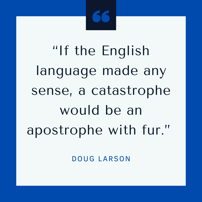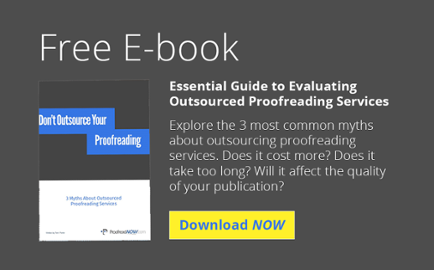 Punctuation marks are teeny, but they should never be underestimated. They inform the literal and implied meaning, cadence, and emotion of every word we write (and read). That said, sometimes the average exclamation mark or serious serial comma or even an enthusiastic em dash doesn’t cut it. You need something with more flair and precision — an uncommon punctuation mark.
Punctuation marks are teeny, but they should never be underestimated. They inform the literal and implied meaning, cadence, and emotion of every word we write (and read). That said, sometimes the average exclamation mark or serious serial comma or even an enthusiastic em dash doesn’t cut it. You need something with more flair and precision — an uncommon punctuation mark.
This list is the grammatical equivalent of a chef’s special. The VIP lounge. The decorative embellishments of an A-grade interior designer. Prepare to surprise and impress people with 13 uncommon punctuation marks and how to use them. And fair warning: Your writing may never be the same.
The acclamation point is used to demonstrate an enthusiastic sense of goodwill or welcome and is placed at the end of a sentence. You could use it when greeting your mother-in-law for a monthlong stay (assuming you love her very much).
2. Asterism ![]()
In astronomy, an asterism is a group of stars. In punctuation, an asterism is used to divide chapters, verses, stories, or any other elements in a text. It’s also known as a “triple symbol” — three solid points that form a triangle. Publishers and copywriters don’t typically use them anymore, opting for line breaks and bolded lines instead. Which is too bad, since they’re so cute.
3. Authority Point ![]()
When writers use an authority point, it indicates they have the expertise and authority to back what they just wrote. It also indicates that what they wrote should be taken seriously. We do not recommend using this if you’re trolling other people (e.g., “I’ve been to the moon; it’s a cardboard satellite made by NASA.”).
4. Caret ![]()
The word “caret” is Latin for “it lacks.” The caret is mainly used to indicate something that's missing from the original text. It’s not as commonly used anymore, but it’s a great little tool when you’re editing on paper like a true dinosaur.
5. Certitude Point ![]()
While this looks identical to the authority point at a glance, the horizontal line on the certitude point doesn’t curve downward. When using this, writers are claiming they’re very confident in what they’ve just written but aren’t necessarily stating they have the research to back up what they’re saying. This punctuation would best be used instead of writing in all caps (because no one likes to be yelled at).
6. Dagger and Double Dagger 
This punctuation is also called the obelisk. It was once used by editors to indicate superfluous/repetitious text that needed to be cut. Now, however, it’s often used to indicate a footnote on a document when an asterisk has already been used, and is sometimes called the “reference mark.” We recommend it because it’s fancy.
7. Doubt Point ![]()
This punctuation indicates doubt. So, instead of using a string of question marks at the end of a statement a writer is unsure about, such as “We’re going to the store now???” he or she would insert the doubt point instead. And please don’t use multiple question marks unless you’re in middle school.
An ElRey mark should be used at the end of a sentence to indicate positivity and joyfulness, but not over-the-top joyfulness. When a writer is feeling positive, but not literally jumping up and down with excitement, he or she should use this punctuation. If we had to guess, we’d say an introvert invented this punctuation mark when they were leaving a party.
9. Hedera ![]()
The word “hedera” in Latin means “ivy.” The hedera punctuation was intended to look like an ivy plant and was used to separate paragraphs in written documents. It’s no wonder it’s not commonly used, at least not in handwritten texts, as it’s challenging to write quickly, especially for people with no artistic talent (such as the author of this post).
10. Interrobang ![]()
If you want to ask a question excitedly, use the interrobang instead of “?!” at the end of the sentence. This is perhaps one of the more useful punctuation marks on this list, as it could easily be used often. It’s used to express surprise and unbelief simultaneously (e.g., You're saying “The moon is a cardboard satellite held up by clear fishing line‽”).
11. Irony Point ![]()
The irony point looks like a backward question mark. It sometimes has a more pronounced squiggle in the larger piece above the point and can be smaller in size. It typically precedes a written passage and is a combination of an irony mark and a percontation point. It’s used to indicate there may be a hidden subtext or second layer of meaning in a sentence; a meaning that can’t be derived literally from the text. A lot of literature enthusiasts, however, might think that this punctuation takes all the fun out of reading a text. Sometimes this punctuation is used for rhetorical questions that don’t require a real answer and is called a rhetorical question mark.
 This punctuation is also often used interchangeably with the “sarcasm mark” (see left) or the “snarkmark." The sarcasm mark is used to indicate a sarcastic passage of text, which also has a double meaning that shouldn’t be taken literally.
This punctuation is also often used interchangeably with the “sarcasm mark” (see left) or the “snarkmark." The sarcasm mark is used to indicate a sarcastic passage of text, which also has a double meaning that shouldn’t be taken literally.
12. Love Point ![]()
The love point has been replaced with the face emoji that has enlarged heart-shaped eyes. But when used, it expresses a mirrored sentiment or emotion, or amorous subtext. You should probably giggle when you use it.
13. Because Point ![]()
The “because point” is used to give more information after a line of text. It’s an inverted form of the “therefore” sign and means exactly what its name implies: because. It also looks like a frightened ghost, so if you’re trying it out for the first time, maybe write about something terrifying before explaining why (i.e., the “because”) it’s so scary.
****
Which ones were you already familiar with? Which punctuation marks do you want to try? (Bonus points if you use one of them in your answer.)
Thanks for reading! Check out more grammar-related posts on the blog using the search tool.




